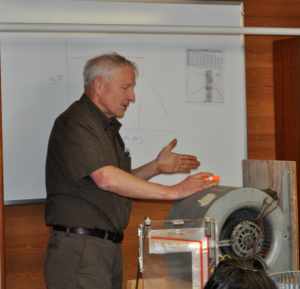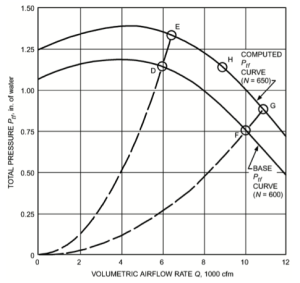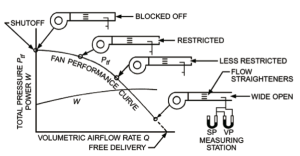 Fans and air handling equipment represent a large and important segment of building systems design. There are a few important principles which are very useful and easy to remember when approaching a fan problem. This article outlines a few of those considerations.
Fans and air handling equipment represent a large and important segment of building systems design. There are a few important principles which are very useful and easy to remember when approaching a fan problem. This article outlines a few of those considerations.
The standard reference for most fan problems begins with the ASRAE Manuals for systems and equipment, specifically chapter 21. A quick overview reveals several common fan types:
1. Centrifugal Fan – commonly called a squirrel cage fan
2. Backward inclined fan – airfoil blades
3. Vein Axial Fan – commonly called a propeller fan
4. Plug fan -essentially a centrifugal fan without a housing used to circulate rather than transport air.
The equations that govern fan performance are called the Fan Laws:
CFM vs. RPM; RPM1 / RPM2 = CFM1 / CFM2
Vs. Static Pressure SP1 / SP2 = (CFM1 / CFM2)^2
Vs. Horsepower HP1 / HP2 = (CFM1 / CFM2)^3
A more detailed analysis of the fan laws can be found in chapter 21 of the ASHRAE Manual.
Useful Fact:
If you want to increase CFM by 10% you need to increase horsepower by 33%. In other words, it is always easier to slow down a fan than to increase the volume. By moderately over-sizing a fan, the engineer gains performance flexibility little or no efficiency loss.
Fan Curve:
From the 2012 ASHREA Manual, a typical fan curve. Performing tests of certain fan configurations creates the Fan curve. From The ASHREA Manual, this is demonstrated by the following drawing. A standard fan is started at maximum pressure and slowly opened to maximum flow rate.
When Generalized a typical fan curve looks like this where the dashed lines represent efficiency of the fan. The main thing to remember is never design a fan in the performance envelope outboard of the two dashed lines as efficiency and performance will suffer in practice.
Duct Configurations:
It is important to pay attention to the flow characteristics downstream of the fan outlet. It is best to try and emulate the conditions of the test/reference fan where possible; straight flow for as long a length as practical. This allows the flow to organize before taking a bend or a branch.

